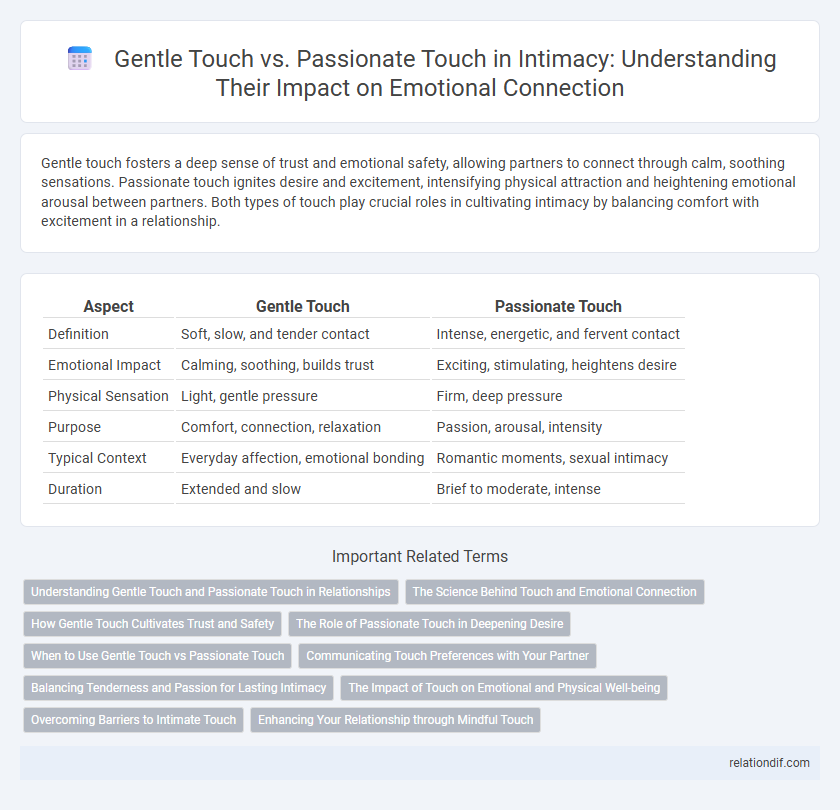Gentle touch fosters a deep sense of trust and emotional safety, allowing partners to connect through calm, soothing sensations. Passionate touch ignites desire and excitement, intensifying physical attraction and heightening emotional arousal between partners. Both types of touch play crucial roles in cultivating intimacy by balancing comfort with excitement in a relationship.
Table of Comparison
| Aspect | Gentle Touch | Passionate Touch |
|---|---|---|
| Definition | Soft, slow, and tender contact | Intense, energetic, and fervent contact |
| Emotional Impact | Calming, soothing, builds trust | Exciting, stimulating, heightens desire |
| Physical Sensation | Light, gentle pressure | Firm, deep pressure |
| Purpose | Comfort, connection, relaxation | Passion, arousal, intensity |
| Typical Context | Everyday affection, emotional bonding | Romantic moments, sexual intimacy |
| Duration | Extended and slow | Brief to moderate, intense |
Understanding Gentle Touch and Passionate Touch in Relationships
Gentle touch in relationships fosters security and trust by activating the parasympathetic nervous system, promoting relaxation and emotional connection. Passionate touch, characterized by intensity and urgency, stimulates arousal and excitement through the release of dopamine and adrenaline, enhancing romantic attraction. Balancing gentle and passionate touch supports both emotional intimacy and physical desire, essential for a healthy, fulfilling partnership.
The Science Behind Touch and Emotional Connection
Gentle touch activates C-tactile afferent nerves, which are closely linked to the brain's emotional centers, releasing oxytocin and fostering feelings of safety and bonding. Passionate touch, involving firmer pressure and stimulation, triggers a stronger autonomic nervous system response, increasing heart rate and adrenaline, which heightens arousal and excitement. Both touch types engage distinct neural pathways that respectively enhance emotional connection and physical desire, underscoring their complementary roles in intimate relationships.
How Gentle Touch Cultivates Trust and Safety
Gentle touch activates oxytocin release, fostering a sense of trust and safety in intimate relationships. It engages the C-tactile nerve fibers, which are specifically responsive to soft, slow stroking, promoting emotional bonding and calming the nervous system. This soothing form of contact creates a secure environment where partners feel understood and valued, enhancing vulnerability and deeper connection.
The Role of Passionate Touch in Deepening Desire
Passionate touch plays a crucial role in deepening desire by stimulating both emotional and physiological responses that intensify attraction and connection between partners. Unlike gentle touch, which promotes comfort and trust, passionate touch activates neural pathways associated with excitement and arousal, leading to heightened intimacy. This type of tactile interaction enhances dopamine release and strengthens the bond through shared vulnerability and intense physical sensation.
When to Use Gentle Touch vs Passionate Touch
Gentle touch is ideal for moments of comfort, reassurance, and building emotional connection, fostering trust and calmness between partners. Passionate touch is better suited for times of heightened desire, intimate exploration, and fostering physical attraction, enhancing excitement and deepening romantic intensity. Recognizing cues like mood, setting, and partner preferences helps determine whether gentle or passionate touch will best nurture intimacy.
Communicating Touch Preferences with Your Partner
Communicating touch preferences with your partner enhances intimacy by ensuring both gentle and passionate touch meet emotional needs. Expressing preferred pressure, duration, and rhythm helps create a mutual understanding that deepens connection and trust. Tailoring touch according to feedback fosters comfort and strengthens the emotional bond in a relationship.
Balancing Tenderness and Passion for Lasting Intimacy
Balancing tenderness and passion is essential for lasting intimacy, where gentle touch cultivates trust and emotional connection, while passionate touch ignites desire and excitement. Gentle touch activates oxytocin release, promoting bonding and relaxation, whereas passionate touch stimulates adrenaline and dopamine, enhancing arousal and intensity. Harmonizing these complementary sensations fosters deeper relational satisfaction and enduring emotional closeness.
The Impact of Touch on Emotional and Physical Well-being
Gentle touch activates the parasympathetic nervous system, releasing oxytocin and promoting relaxation, trust, and emotional bonding. Passionate touch stimulates the sympathetic nervous system, increasing heart rate and adrenaline, which enhances excitement, arousal, and physical vitality. Both forms of touch contribute uniquely to emotional and physical well-being by balancing calmness and stimulation in intimate relationships.
Overcoming Barriers to Intimate Touch
Gentle touch fosters trust and safety, making it essential for overcoming barriers to intimate touch by reducing anxiety and encouraging emotional openness. Passionate touch, while intense, can overwhelm individuals who are hesitant or recovering from past trauma, thus slowing progress in building intimacy. Gradually incorporating gentle touch creates a foundation that supports a healthy transition toward more passionate connections.
Enhancing Your Relationship through Mindful Touch
Mindful touch enhances intimacy by balancing gentle and passionate sensations, fostering deeper emotional connection and trust. Gentle touch activates the parasympathetic nervous system, promoting relaxation and safety, while passionate touch stimulates arousal and excitement, creating dynamic bonding experiences. Integrating both modes of touch mindfully cultivates a richer, more fulfilling relationship through heightened awareness and mutual presence.
gentle touch vs passionate touch Infographic

 relationdif.com
relationdif.com